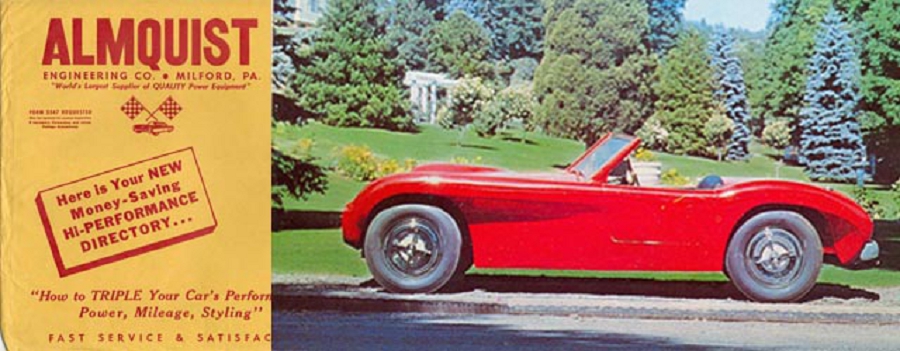
Hi Gang…
What a great group of folks we have here at Forgotten Fiberglass. I’m lucky to hear from many of you via comments on the stories and replies via e-mail. Keep ‘em coming gang!
Today’s story is a result of the keen eyesight of Doretti Historian and good friend Tom Householder. Recently Tom sent me a link about a great article on the web that focused on the life and times of Ed Almquist written by Donna Kessler. I contacted Donna and asked for her permission to re-run the article here – which I am pleased she was able to provide earlier today.
So…. let’s learn more about Ed Almquist from a great author and researcher – now a friend of fiberglass – Donna Kessler.
Off we go!
Ed Almquist, Motorhead Inventor and Pioneer
Times Herald-Record Newspaper: March 2nd, 2009
By Donna Kessler
His inventions include floor shifters, the six-electrode Sparkomatic spark plug and the gas-saving device called the Ram-Jet. Over the years he designed and manufactured more than 100 speed and custom equipment products and wrote more than a dozen speed part catalogs.
In the early days, the legendary drag car racer Don Garlits even ran this guy’s equipment in his dragster. The racing equipment pioneer/inventor is Ed Almquist of Milford, Pennsylvania. Ed was born in Zim, Minnesota. Toys were few and far during the Depression, so 10-year-old Ed occupied his playing time with his Maytag-engined “soapbox racer.”
By age 14, he was using his mechanic skills on a Model T Ford that he found in a junkyard. Not having the money to attend college, Ed worked as a celery farmer and a part-time railroad brakeman, and took extension courses in diesel engineering from the University of Minnesota. With World War II going on, he joined the U.S. Maritime Service in the early ’40s and later became a licensed marine engineering officer.
Writes A Manual:
In 1946, while still in the military, Ed wrote his first hot rod book, “Speed and Mileage Manual,” during his free time on the ship. It was a basic how-to manual, concentrating on making racing engines more powerful and introducing some customizing tricks that he knew.
This was more than two years before Hot Rod Magazine came out, so it was a time when there were really no car magazines, so he advertised his book in Popular Mechanics in a 1-by-1-inch ad. The tiny ad brought in $200 in orders plus requests for speed equipment. It was a hit, something Ed never expected. Ed had found his calling.
Ed even had a chance meeting with Henry Ford himself aboard the ship Henry Ford II. It was a meeting that a young sailor would never forget and one that would change his life. “That particular day, I boldly seized the opportunity to speak to the great automobile magnate about souping up my Ford V-8 powered ‘Tin Lizzy,'” Ed said. “Despite my clumsy approach, Mr. Ford responded to my naive questioning.
Coupled with his adamant advice to avoid over-carbureting, he added his final words: ‘Call it modifying, not souping.’ Thanks to one of America’s first true rodders, I became a lifelong hot rod and performance equipment pioneer.”
After being discharged from the service, Ed moved to Milford, Pa., where he still resides with his wife, Marion. He began designing speed and custom products. One of his first inventions was a water/alcohol vapor injector, made from a Mason jar, that he assembled at his home.
The apparatus cost 50 cents to make but sold like crazy for $6. Another invention, the “log manifold,” could adapt two carburetors to virtually any car giving the vehicle quicker acceleration than a four-barrel and all for only $12.95. “They sold like crazy,” Ed said.
He later rented a room for $35 and began Almquist Engineering, which turned out to be one of the largest mail order speed equipment businesses in the country. As business began to expand, he moved to a gymnasium and just partitioned off the part he was using.
But the business was growing by leaps and bounds, and every time he moved the partition to make more room it would cost him $50 more. California speed manufacturers may have had the West Coast, but Almquist equipment was the choice in the Midwest and on the East Coast.
Designing such parts requires testing. “Route 84,” Ed responded. “There wasn’t as much construction on that road as there is today.” Sometimes his testing was mistaken for something else. There was a time when he was testing a product that measured the amount of emissions coming from a car.
He put the apparatus on the seat of his car and ran a garden hose from the exhaust pipe in through the car window to the emissions tester. He then drove the car down a back road and parked. Well, a neighbor saw the car with the garden hose and called the police thinking that he was trying to commit suicide.
The police asked the woman if it was a yellow car. She said yes and they responded by saying, “Oh, that’s just Ed Almquist doing another test. It’s OK.” In 1954, Ed, with his partner, Jonas Anchel, turned Almquist Engineering into the Sparkomatic Corp. In 1959, Ed and Jonas entered into a partnership with George Hurst and Bill Campbell, who were making engine conversion mounts and saw the need for an aftermarket floor shifter.
After each designed a floor shifter, however, the partnership mutually dissolved. Ed then came up with a fits-all universal mounting kit that helped dealers minimize inventory. Ed received two patents on the product. He was also the co-designer of the Hurst Shifter used in hundreds of hot rods.
His shifters could be purchased through Montgomery Ward, JC Whitney, Sears, Firestone and Western Auto. Every year or two, Ed would come out with a new catalog during the ’50s and ’60s. In 1955, he bought Clearfield Plastics, an early manufacturer of fiberglass kit cars. In the years to follow, he produced a number of Almquist kits to fit different-size chassis. His first kits were made to fit the Crosley and Fiat Topolino automobiles.
Ed sold Almquist Engineering and his half of Sparkomatic in 1966 and went right into the lubricant business. Perma-Power, Ed’s “horsepower in a can,” was proven by the U.S. Department of Energy to increase power and mileage while reducing wear by 50 percent. Race car drivers continue to use the product today.
Spotlight on ‘Pioneers:’
In 2000, Ed wrote a wonderful book titled “Hot Rod Pioneers: The Creators of the Fastest Sport on Wheels.” It records the history and the profiles of more than 200 innovators and legends of the sport, including Don Garlits, Bob Glidden, Ray Stillwell (our very own local boy) and Vic Edelbrock to name a few.
In an old wooden bookcase, in the corner of his living room, Ed has a collection of all the parts he designed and manufactured. As he struggled to lift one of the doors, it hit me what an amazing man Ed Almquist is and what important contributions he has made to the racing industry.
He single-handedly made horsepower what it is today. Even though Ed retired about 10 years ago, the wheels continue to turn and his innovations to the racing industry are still being manufactured in Huguenot, Pa. Today, nobody speaks about racing without mentioning the name Almquist in the same sentence.
————————
Donna Kessler is the writer of the “My Ride” feature that appears every week in the Times Herald-Record in Middletown, N.Y. Visit www.recordonline.com/myride or visit the “My Ride” page on Facebook. Email: dkessler@th-record.com
————————
Summary:
Thanks again to Donna Kessler for a wonderful story on the life and times of Ed Almquist as well as her permission for running the story here at Forgotten Fiberglass. Thanks Donna 🙂 Click here if you would like to review Donna’s original article on the web.
Hope you enjoyed the story, and until next time…
Glass on gang…
Geoff
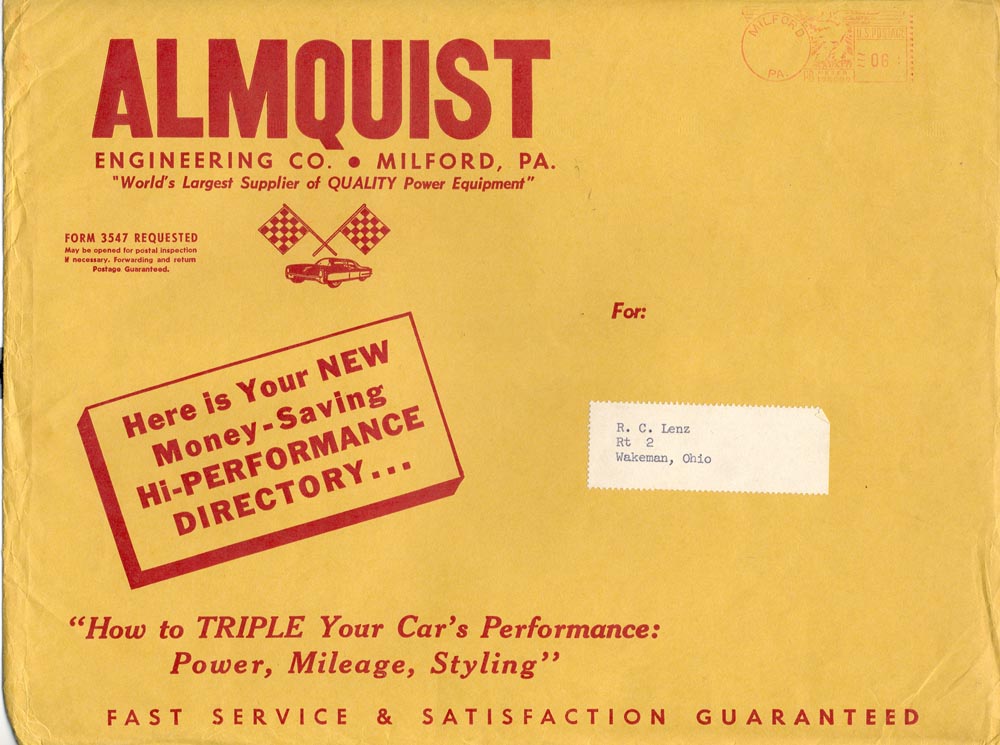
——————————————————————-
Click on the Images Below to View Larger Pictures
——————————————————————-
- Rick D’Louhy and I Had A Chance To Meet Ed And Marion Almquist Back In The Winter of 2008/2009.
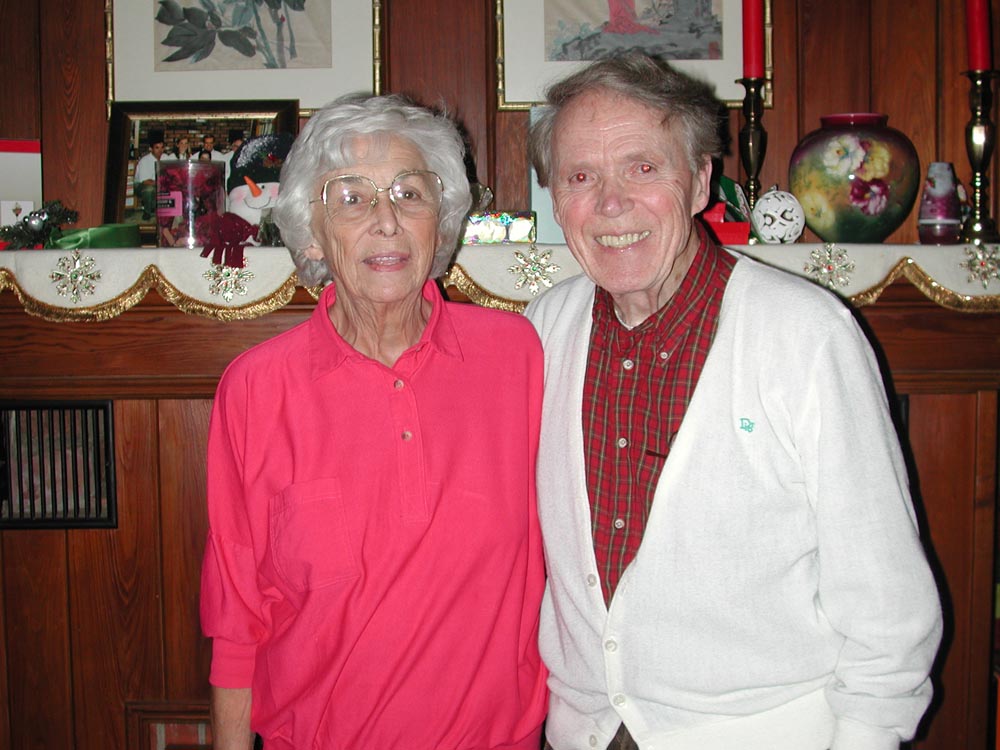
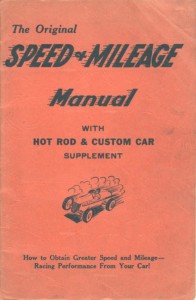
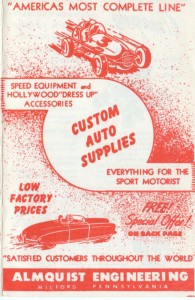
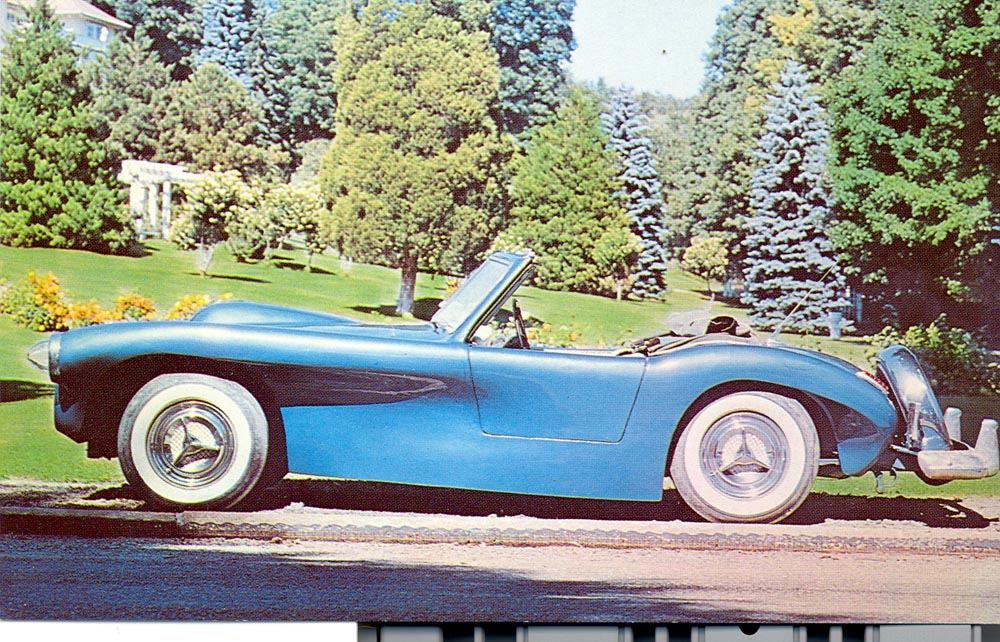

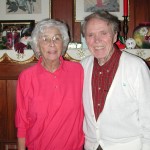
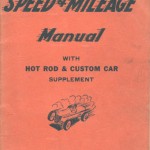
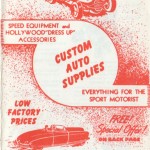
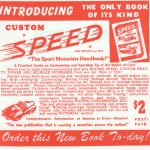
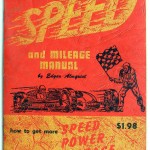
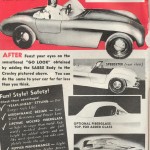
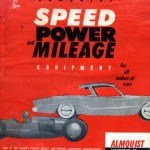
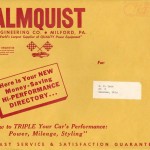
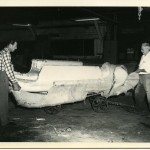
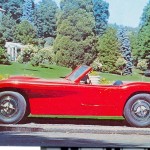
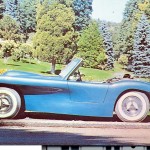

I also did not realize that Ed Almquist bought Clearfield Plastics! It is my recall that Clearfield Plastics discontinued doing business, and Harry Heim set up shop at another address in Clearfield, PA., under the corporate name of Harry Heim and Associates. At that time, I was comissioned, via Harry Heim, by Ed Almquist/John Anshel to install a larger body on an early fifties Ford convertible chassis. Geoff Hacker has photos of this unfinished, insured/licensed vehicle that summarily was presented in Almquist’s showroom as a display vehicle for this now-Almquist body, and for a variety of accessories, many of which Mr. Almquist produced. Thanks again, Bob, for presenting this assumption of Clearfield Plastic’s history. It is difficult for all of us to sort through the truth and the often unintended rumors regarding businesses that seemed to have such promise, that disappeared or were revived under new management, funding. whatever. The original investors, and there were many, were very convinced, and for good reason, that Harry Heim could do the job ! As in many situations when local business people invest in a well promoted company, and it fails, those people are often reticent to discuss that new company’s demise. Harry stayed in Clearfield, and continued with his work in fiberglass that included several U S Government contracts, and international endeavors. He moved his company to Milford to be more in proximity to Almquist Engineering, where he and Ed Almquist continued to collaborate on myriad outstanding products. Years later, he moved his business to East Stroudsburg, PA. Under the name of GLASPOT, he continued to manufacture items such as heart shaped, red
Fiberglass spas and bathtubs for nearby resorts. He designed and fabricated a beautiful two seat fiberglass body that he affixed to a Corvair chassis, and was commissioned by several Corvair owners, to prepare their vehicles for competition. His shop sported a Thunderbolt Coupe of his and Ed’s design, that was in for a repaint; the car belonged to one of the Gabor sisters.
Harry H. Heim lll was born March 23, 1914. He passed away following surgery
on June 7, 1988 . At the memorial service at the Stroudsburg Methodist Church, on Sunday, June 12, friends and associates gathered to celebrate Harry’s
life. Ed Almquist and I were particularly saddened that this very special friend and associate would no longer would be with us, but we knew that he had contributed in so many ways to so many peoples’ lives. Those of us who knew Harry Heim are most thankful to Geoff Hacker for inviting us to memorialize him
through Geoff’s pursuit of the history of The Forgotten and Fabulous Fiberglass Sports Cars of the Fifties.
I did not realize that Ed bought Clearfield Plastics in 1955. He must have purchased it right after Clearfield built and installed the body on the three-wheeled Tri-Car, which debuted in the Universal Travel & Auto Sports Show, in New York. I wonder if he can shed any light on why no more were built — they expected to build thousands in assembly stations around the country. Clearfield was to be the home office, with all research and development centered there.
~ what an interesting man. always fascinating to know of the relationships between these brilliant men. thanks Donna & Geoff. yet another in the endless string of great stories.
Fantastic article! I didn’t realize what a pioneer Ed Almquist is. It’s fun to learn “the rest of the story.”